The journey to the Retired Racehorse Project Thoroughbred Makeover 2020 continues! Read on for our first update from Amy Smith. Amy discovered her RRP horse while volunteering for the Communication Alliance to Network Thoroughbred Ex-Racehorses (CANTER). CANTER provides retiring thoroughbred racehorses with opportunities for new careers by helping to place, rehabilitate, and retrain these athletes.
Journey to the RRP: The CANTER Listing that Never Was
During an August round at Laurel Park in my role as Executive Director of CANTER Maryland, I fell headfirst into a trap I have only been tripped up by once before in my many years of volunteering for CANTER – I fell in love with a listing and caved to the temptation. “Chief Tarhe” was the fourth of five horses pulled out of his barn for pictures that morning, and my brain was already calculating the division of my bank account by an additional horse as I laid a hand on him. The division was a little painful, but my heart wasn’t listening.
My own path to the RRP began many years before that morning. I learned to love thoroughbreds before I could count my age in double digits, and before I ever learned how to ride a horse. I grew up lurking in the grandstand of Hialeah Racecourse in Miami during early morning hours, watching workouts and tracking horses and their respective saddle pads as if I was about to record workouts for the Racing Form. “Breakfast at Hialeah” was the ‘blue collar’ mom’s way of satisfying her daughter’s inexplicable but desperate need for horse exposure (free – aside from the breakfast sandwich!)
It was a natural progression to want to be part of the mission of ‘recycling’ racehorses when I eventually learned to ride and arrived at a financially solvent state of adulthood (that peaceful place we’re waiting for while suffering through the post-college Ramen noodle eating, once-a-week lesson barn up the road phase of life). I acquired my first post-childhood horse straight from the Penn National CANTER listings 15 years ago, a big bay war horse named “Silent Thunder.”
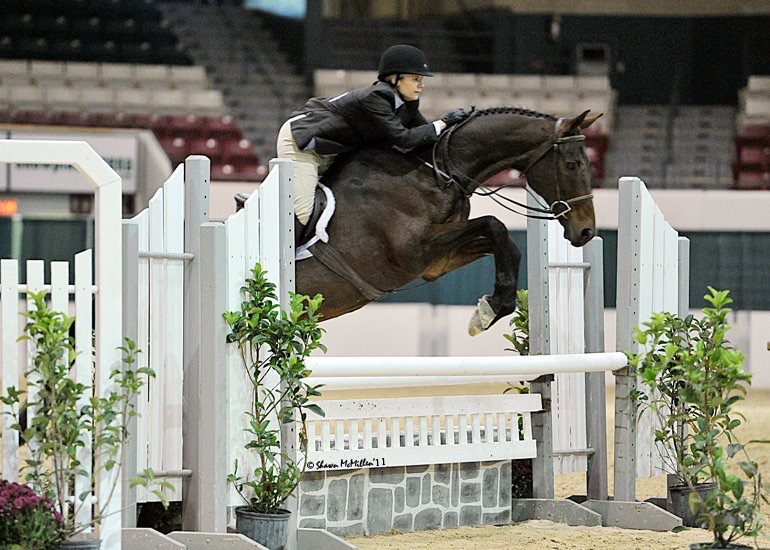 Amy Smith on Silent Thunder at the Washington International Horse Show Regionals, 2011. Photo by Shawn McMillen Photography.
Amy Smith on Silent Thunder at the Washington International Horse Show Regionals, 2011. Photo by Shawn McMillen Photography.
Back then, the amateur voice in my head wondered how far I’d be able to advance Thunder’s transition on my own before I’d need to find a professional to completely take over. It turned out that with patience, research, and occasional lessons, Thunder and I were able to build the new partnership ourselves, one brick at a time. He and I went through many ‘firsts’: First busted cross-ties. First (VERY) hard keeper. First bad turnout experience (complete with injury). First saddle search for withers that resembled a shark fin. First freak out with other horses in his ring. First cross rail. First gymnastic. First horse show experience. First ribbons. First championship.
Since those first days and many years with Thunder, I have taken on this challenge twice more, with Chief Tarhe being my newest commitment. If there’s anything I’d want to emphasize at the outset of our journey, it’s this: I was infatuated with his looks when he came rolling out of his stall on that August morning to get his listing taken, but the reason he came home with me was his disposition. As an amateur rider who wants to tackle these transitions myself, I know my own limitations and prioritize the need to choose a horse that has a good brain. The barn is my escape, and I want a horse that I love spending time with…on his back, in his stall, or for leisurely grooming sessions. I did my homework – I talked to his groom, current and former exercise riders, and spent some time in his stall with him.
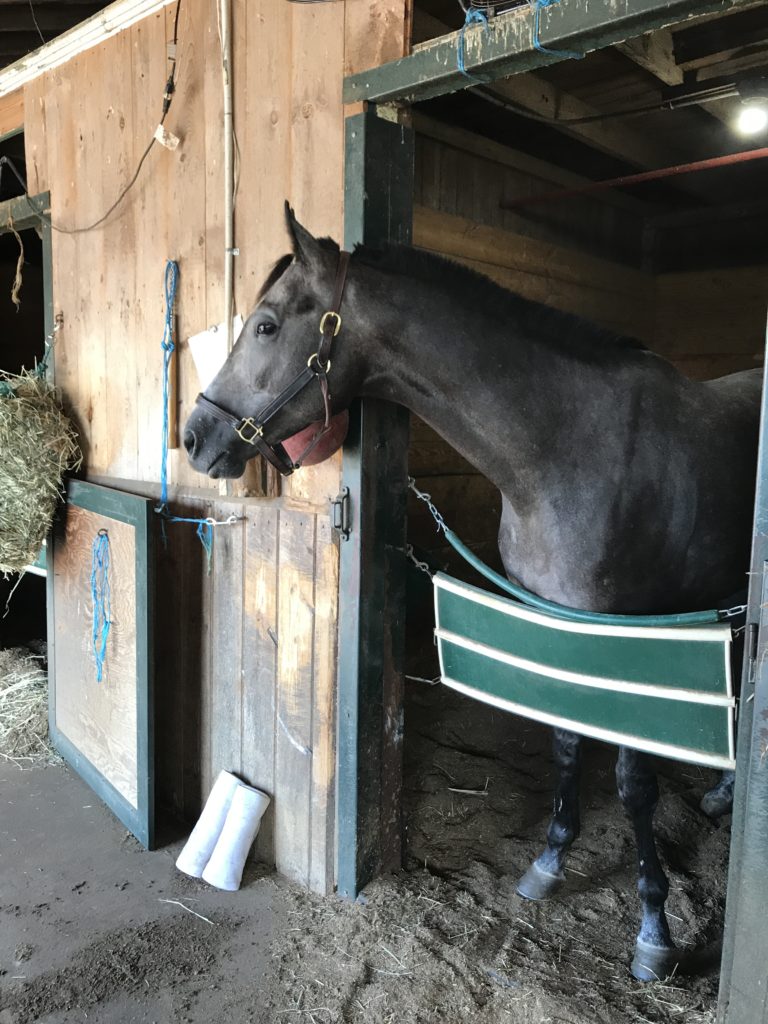 “The Chief” in his stall in the Corrales barn, Laurel Park. Photo by Amy Smith.
“The Chief” in his stall in the Corrales barn, Laurel Park. Photo by Amy Smith.
This main box was checked with “The Chief,” but there was one more thing that needed review before I was ready to roll in hot with a horse trailer – a large osselet on his right fetlock. My vet came to Laurel Park, and after a series of flexions and inspection, he gave me a thumbs up. When making CANTER rounds, I’ve listed dozens (probably hundreds) of horses with “track jewelry” of this nature. My teeth always grind when I read online commentary from people condemning these things as if there is a blanket outcome for all horses with such a blemish. I love my vet, who appreciates OTTBs and once told me that track purchases were like a “scratch and dent” sale:
“Most are banged up a little, but sometimes it’s just cosmetic. Sometimes they need time, proper care, or some procedure. If you can be patient and do the work, you can find real diamonds in the rough here.”
His first question to me when he arrived at Laurel Park for the vet check was, “Is he for you, or is he for resale?” (In other words – Are we spending more money on X-rays today than the check you’re writing to actually buy him?)
Did I mention that I love my vet? He gets me.
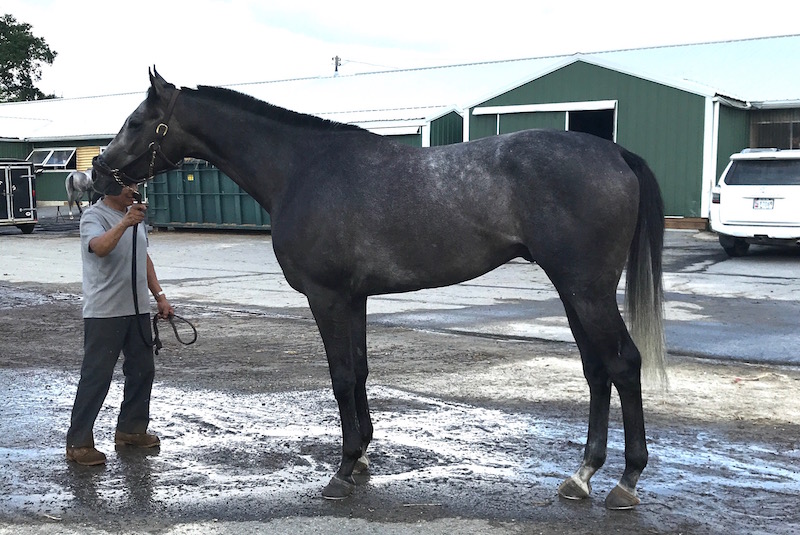 Conformation shot for The Chief’s CANTER listing that never was needed! Photo by Amy Smith for CANTER Maryland.
Conformation shot for The Chief’s CANTER listing that never was needed! Photo by Amy Smith for CANTER Maryland.
On August 31, 2019 I drove “The Chief” in my two-horse straight load to the barn where I board, and our road together began. I gave him about six weeks to adjust to farm life and his new diet, to get new and proper shoeing, and for us to get to know each other.
 Ghost enjoying one of his first turnout days. Photo by Amy Smith.
Ghost enjoying one of his first turnout days. Photo by Amy Smith.
I also reluctantly made a decision on a name change for him, for non-Makeover shows and around the barn. Although my first two OTTBs had Jockey Club names that worked well enough, I didn’t want to see how many ways the name “Tarhe” could be distorted. It also didn’t help much that “Tarhe” was apparently the name of an Indian chief who fought with my Cherokee ancestors. So, as a nod to our family connection to the Navy (and a recent book I’ve read) I christened “Chief Tarhe” with his new moniker “Ghost Fleet” (barn name: “Ghost” – perfect for a big grey).
Once we started work under saddle, Ghost made quick work of demonstrating what our biggest initial challenge would be, and it was a new one for me: GIRAFFE NECK. When I’d ask for light contact (using legs, seat, and a very simple, gentle ergonomic D-ring bit) I’d get the head-in-the-air, hollowed-out back reaction. I ended up removing the martingale because I didn’t want him to lean against it.
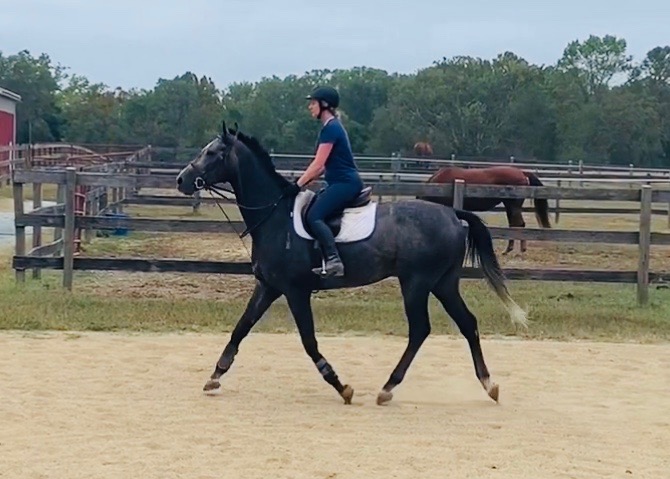 Demonstrating giraffe neck in late October, 2019. Photo by Amy Smith.
Demonstrating giraffe neck in late October, 2019. Photo by Amy Smith.
Giraffe Neck made me ride too far forward as a subconscious way of compensating. We started working with a trainer who actually focused on my position – getting me to sit back and really put my legs on him. It turned out to be a good problem to have (insert amateur rider admission here) because to fix it properly, I needed to fix myself. We also put so much focus and effort into flat work that I think both of us have built a fantastic foundation for all that comes next. Ghost now feels balanced and light, and he moves off leg pressure like a champ.
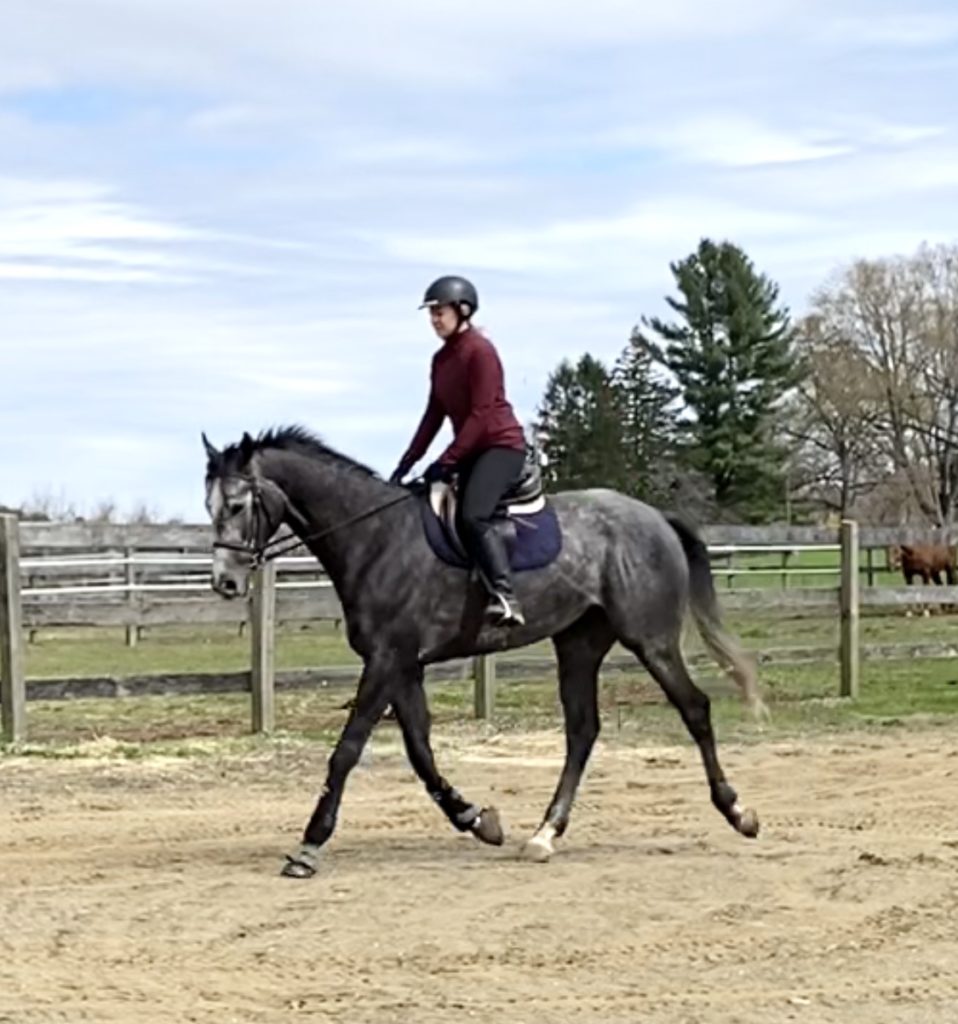 Ghost’s progression as of March 21, 2020. Photo by Amy Smith.
Ghost’s progression as of March 21, 2020. Photo by Amy Smith.
When I realized that Ghost was RRP 2020 eligible, I asked a fellow CANTER volunteer for her opinion on aiming for the Makeover. She said, “You keep your horses, so this is your chance.” I realized she was right. I have never sold a horse, and Ghost is another intended lifetime acquisition. I’m excited to experience the Makeover, which has become the centerpiece of a cause I have been committed to as a volunteer and a horse owner. So far, I’m very excited about the horse I’ve chosen to take the journey with me.
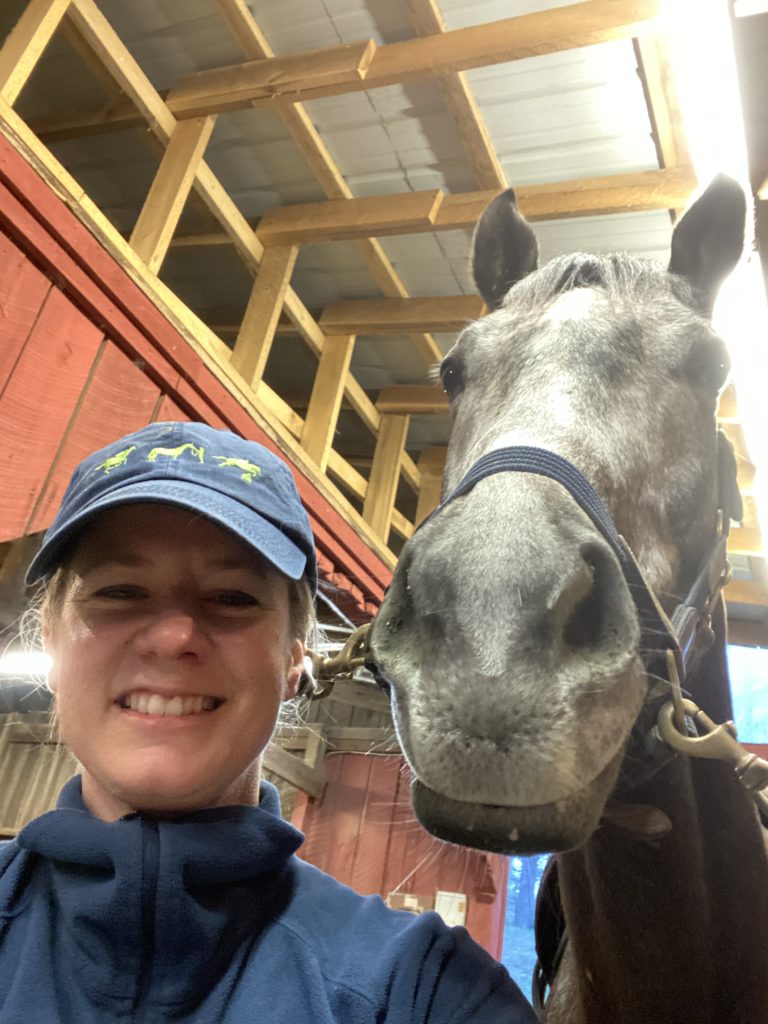 Amy and Ghost. Photo by Amy Smith.
Amy and Ghost. Photo by Amy Smith.
Want to follow along on Amy and Ghost’s journey before their next blog update? Click here to “like” and follow their Facebook page!
About Amy
Originally from Homestead, Florida, Amy Smith moved to the DC area after college and went on to work on Capitol Hill for almost 17 years. She now works for The Boeing Company. She also is an active duty military spouse married to her husband, Russ, and is involved in several volunteer activities/charitable organizations, including serving as a board member for the Navy Marine Corps Relief Society and a Tragedy Assistance Program Ambassador. Amy has ridden horses since she was a young child and has purchased and re-trained three OTTBs since 2005: Silent Thunder, National Standard, and Chief Tarhe (Ghost). She began volunteering for CANTER Mid-Atlantic in 2007 and became the Executive Director for CANTER Maryland in 2016. She visits the backstretch of Laurel Park approximately twice per month to take listings from trainers looking to rehome their horses, and has helped place homes for hundreds of horses in her years at both Laurel Park and Pimlico.
